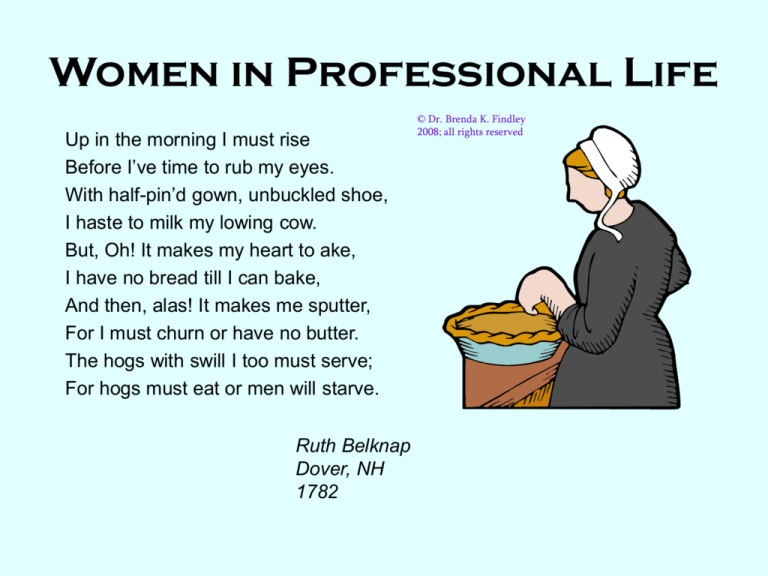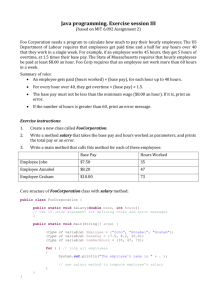
Women in Professional Life
Up in the morning I must rise
Before I’ve time to rub my eyes.
With half-pin’d gown, unbuckled shoe,
I haste to milk my lowing cow.
But, Oh! It makes my heart to ake,
I have no bread till I can bake,
And then, alas! It makes me sputter,
For I must churn or have no butter.
The hogs with swill I too must serve;
For hogs must eat or men will starve.
Ruth Belknap
Dover, NH
1782
© Dr. Brenda K. Findley
2008; all rights reserved
The 1800s
The Civil War / The Rise of the Industrial Era
While the men were
gone to fight in the Civil
War, women flocked to
the factories looking for
work.
Many of them continued
to work after the men
returned.
The 1800s
Increasingly, women moved into
clerical positions.
Some new professional fields were
filled almost entirely by women.
1900s – 1920s
World War II
The 1950s – 1970s
The Equal Pay Act
of 1963
”No employer … shall discriminate, within any
establishment in which such employees are
employed, between employees on the basis of sex
by paying wages to employees in such
establishment at a rate less than the rate at which
he pays wages to employees of the opposite sex in
such establishment for equal work on jobs the
performance of which requires equal skill, effort, and
responsibility, and which are performed under similar
working conditions…..”
The Civil Rights Act of 1964
Prohibited employment discrimination on the
basis of race, color, religion, sex, or national
origin , including:
• Hiring;
• Promoting;
• Firing
Title VII of the Civil Rights Act of 1964
Established the Equal Employment Opportunity
Commission (EEOC)
Currently enforces the laws that prohibit employment
discrimination on the basis of race, color, religion, sex,
national origin, disability, or age , including:
• Hiring;
• Promoting;
• Firing;
• Setting wages;
• Testing;
• Training;
• Harassing
Executive Order No. 11246 (1965)
“Affirmative Action”
President Lyndon B. Johnson ordered all
executive agencies to require federal contractors
to "take affirmative action to ensure that
applicants are employed and that employees are
treated during employment without regard to
race, color, religion, sex, or national origin." This
marked the first use of the phrase "affirmative
action."
Executive Order No. 11375 (1967)
Amending Executive Order No. 11246,
Relating to Equal Employment Opportunity
” It is the policy of the United States Government to
provide equal opportunity in Federal employment and in
employment by Federal contractors on the basis of merit
and without discrimination because of race, color,
religion, sex or national origin.”
Two Landmark Cases
Schultz v. Wheaton Glass Co. (1970)
U.S. Court of Appeals for the Third Circuit
Ruled that jobs need to be "substantially equal" but not "identical"
to fall under the protection of the Equal Pay Act. An employer could
not, for example, change the job titles of women workers in order to
pay them less than men.
Corning Glass Works v. Brennan (1974)
U.S. Supreme Court
Ruled that employers cannot justify paying women lower wages
because that is what they traditionally received under the "going
market rate." A wage differential occurring "simply because men
would not work at the low rates paid women" was unacceptable.
Title VII of the Civil Rights Act of 1964
Place a chair against a wall. Have
the person stand just in front of the
chair, then bend over until their back
is horizontal and their head rests
against the wall also. Then, ask
them to pick up the chair while
straightening their back, without
pushing off against the wall with
their head.
Men find this impossible because of
their higher center of mass, while
women have no difficulty.
The Pregnancy Discrimination Act
(1978)
Bans employment discrimination against
pregnant women.
Pregnant women cannot be fired, denied a
job or a promotion, nor can they be forced
to take a pregnancy leave if they are willing
and able to work.
The EEOC v. “Hooters”
Hooters says women,
not the food, are their
product, making it
legal to hire only
female waiters.
Significant Sexual Harassment Lawsuits
Tompkins v. Public Service & Gas Co. (1977)
Established quid pro quo and employer liability
Brown v. The City of Guthrie (1981)
Established “Hostile Environment” as a component of sexual
harassment
Robinson v. Jacksonville Ship Yard (1991)
Nude pin-ups in the workplace can constitute a hostile
environment
Ellison v. Brady (1991)
Established the “Reasonable Woman” criterion.
Burlington Industries, Inc. v. Ellerth Kimberly (1998)
Made hostile work environment as serious as quid pro quo in
sexual harassment suits.
The Civil Rights Act of 1991
Allowed for recovery of punitive damages
in cases where the complaining party
demonstrated that an employer had
engaged in discriminatory practices with
"malice or with reckless indifference to
the federally protected rights of an
aggrieved individual.”
Kolstad v. American Dental Association
(1999)
The Supreme Court determined that by using
the phrase “reckless indifference,” Congress
meant to authorize punitive damages
whenever an employer was aware of its
obligations under Title VII but engaged in
unlawful disparate treatment of employees.
The Salary Issue….
In 1950 33.9% of women participated in the
labor force.
By 1998 59.8% of women were working
outside the home.
In 2008 women make up about 48% of the
labor force.
The Salary Issue….
“I don’t get the salary the men clerks do, although
this day I am six hundred sales ahead! Call this
justice? But I have to grin and bear it, because I
am so unfortunate as to be a women.”
Iowa shoe saleswoman, 1886
“Women as rule don’t see job promotion – their
emotions are secure in a limited job.”
Handbook for Supervisors, 1968
The Salary Issue….
Since the passage of the Equal Pay Act
(1963) the wage gap has narrowed, but it is
still significant.
Women earned 59% of the wages men
earned in 1963; in 2005 they earned 81% of
men's wage.
Several explanations for the wage gap have
been offered.
The Salary Issue….
Possibility #1. Many older women work in
jobs still subject to the attitudes and
conditions of the past.
In 2006 women under age 25 working fulltime earned 94% of men's salaries.
Women older than 25 earned 80% of what
men made.
The Salary Issue….
Possibility #2. Women are less likely to be
perceived as being reliable in the workplace.
In 1998 the U.S. Department of Labor
reported that 5.1% of women were absent in
an average work week, compared with 2.7%
of men.
The Salary Issue….
Possibility #3. Women are less likely to be
consistent in their career development.
In 1998 the U.S. Department of Labor
reported 4.5% of families have a father who
stays at home, while 30% of mothers leave
their jobs to care for children.
The Salary Issue….
Possibility #4. Women are more likely to
choose lower paying jobs.
The Salary Issue….
Possibility #5. Welfare reform in during the
1990s has pushed an additional group of
less-able women into the workforce.
The Salary Issue….
Possibility #6. Innate differences between
the sexes mean that women don’t seek highrisk jobs, or don’t perform them as well.
The Salary Issue….
Possibility #7. Sexism is alive and well in
the workplace.
As long as we continue to see court cases
relating to sexual harassment, discrimination
in employment practices, and unfair pay
practices, reasonable people will make this
assumption.
The Salary Issue….
Possibility #8. Unconscious bias continues
to interfere.
Unconscious bias may also be the reason
that women still do the majority of the
housework and child-rearing – making it
harder for them to compete effectively in the
workplace.
The Salary Issue….
Possibility #8 (continued). Unconscious bias
continues to interfere.
Ambitious
Am-bitch-ous
The Salary Issue….
For men, ambition is considered a necessary
part of life.
Women are more likely to be demure when
praised for their achievements.
The Salary Issue….
Necessary Dreams: Ambition in Women’s
Changing Lives by Dr. Anna Fels
Cultural ideals of femininity may be the underlying
problem.
To appear feminine, women must provide or relinquish
scarce resources to others.
“The mandate that females provide recognition to males
is a basic requirement of the white, middle-class notion
of femininity.”
The Salary Issue….
Necessary Dreams: Ambition in Women’s Changing Lives
by Dr. Anna Fels
Between the ages of 20 – 40 women must deal
with the hidden requirement to relinquish ambitions
that will enhance only themselves.
Federal Agencies
• Equal Employment Opportunity Commission
(EEOC)
• Wage and Hour Division, US Dept of Labor
• Office of Federal Contract Compliance Programs
• National Labor Relations Board (governs relations
between unions and employers in the private sector)
Lawsuit Limitations and Remedies
STATUTE
LIMITATIONS ON FILING
SUIT
REMEDIES
Title VII / Pregnancy
Discrimination Act
Within 90 days of right to
sue letter (from EEOC)
Back pay; reinstatement;
compensatory & punitive
damages; injunctive relief;
attorney’s fees.
Equal Pay Act
Two years after last
discriminatory act; three
years if act was willful
Up to two years back pay;
liquidated (double)
damages; injunctive relief;
attorney’s fees.
Family Medical Leave Act
(FMLA)
Two years after last
discriminatory act; three
years if act was willful
Back pay; liquidated
(double) damages;
injunctive relief; attorney’s
fees.
Fair Labor Standards Act
(FLSA)
Two years after last
discriminatory act; three
years if act was willful
Back pay; liquidated
(double) damages;
injunctive relief; attorney’s
fees.
Women in the
Workplace
THE
END








